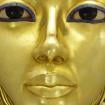Life after Life: Guidebook to Conquering Dangerous Demons and Dark Waters in Duat – Part II
One of the pivots for the successful implementation of ‘heka’, the ancient Egyptian term for magic, was words – both spoken and written – and the latter was considered the most powerful form. Scores of vases, potsherds and voodoo dolls have been found with religious formulae and curses written on them in red ochre (as the color symbolized the powers of destruction) by priests and magicians on behalf of their clients.

Given the choice of colors, this is a rather unusual depiction of Osiris on a sarcophagus lid. Egypt, Second Century AD. Allard Pierson Museum. (Rob Koopman/CC BY-SA 2.0)
Over time, the lines between religious practice and magic blurred as a result. Miriam Lichtheim, the renowned translator of ancient Egyptian texts explains: “The Egyptian was well aware of the distinction between a prayer and a magical spell; but he did not view the ethical-religious approach as incompatible with magical manipulation. Not being inimical, the two approaches could join forces; and their combination in the literary context was something that practiced scribes could evidently do with ease.”

This model coffin and shabti of Wahneferhotep, the King's Son, is made from wood, paint and gold leaf. It was found at the causeway of the pyramid of Senusret I, el-Lisht; Twelfth or Thirteenth Dynasty. Inscribed funerary spells enabled the owner to avoid working in the afterlife. Metropolitan Museum of Art, New York. (Public Domain)
PASSING THROUGH REALMS GUARDED BY MONSTERS
Thus, the Book of the Dead supplied myriad mystical names and spells to utter when the soul was confronted with both malevolent and benevolent entities in its long voyage into the afterlife. With the knowledge of all these techniques, the soul of the dead was equipped to pass a series of gates and realms guarded by terrifying beings and menacing spirits; many depicted with human bodies and grotesque heads of animals and other inexplicable creatures; not to mention monsters made up of different animal parts bearing various kinds of weapons. All this apart, the souls had to voyage through caverns, fields and rivers of fire – which makes the entire exercise sound much like a modern-day videogame – except, for the ancients, it was the real deal.

Large limestone amulet figurine of goddess Sekhmet, the lioness, holding the Eye of Horus Wedjat in her left hand. Harrogate Museums and Arts. (CC BY-SA 4.0)
ETERNITY FOR ALL
From time immemorial, the ancient Egyptians had believed that only the pharaoh possessed a Ba, so it was he alone who could commune with the gods. The fate of commoners was being banished to the realms of darkness and uncertainty. However, during the late Old Kingdom (Ca. 2686–2181 BC) and the First Intermediate Period (Ca. 2181–2055 BC), faith dictated that the Ba was not exclusive to royalty, but was very much an inalienable part of every human being. This epiphany offered everyone a stab at paradisiacal immortality—at least, to those who could afford a tomb and priestly services.

This painted relief that originated from a pillar in the tomb of Seti I (KV 17) shows the pharaoh (right) in the presence of Osiris. Neues Museum, Berlin.
By the New Kingdom period, afterlife theories and beliefs were well-formed. Many funerary texts―such as the Book of Gates, the Book of Caverns, the Coffin Texts, the Amduat (“That Which is in the Afterworld”), and of course, the renowned Book of the Dead― that were rich in ritualistic and mystical chants, spells and prayers were the norm for hope of a secure afterlife for royalty and commoners alike.
BOOK OF THE DEAD A BEST-SELLER
In time, the Book of the Dead became so popular that scribes and artists built an industry around various facets of its production. Thus, we find different classes of people partaking of the benefits of this ticket to immortality. “Most Books of the Dead were simply off-the-shelf versions mass produced by local artists. [Some] were the deluxe version, featuring personal references and grandiose claims,” reveals Dr Joann Fletcher. In fact, scribes who were experts in spells would be consulted to fashion custom-made books for an individual or a family.
This FREE PREVIEW is just a taste of the great benefits you can find at Ancient Origins Premium.
Join us there ( with easy, instant access ) and reap the rewards: NO MORE ADS, NO POPUPS, GET FREE eBOOKS, JOIN LIVE WEBINARS, EXPERT PRESENTATIONS, EXPEDITIONS, WIN GIFT GIVEAWAYS
& more!
- WATCH: Magick - The International Language of Religion, with Mogg Morgan
- Journey to Hell, Featuring Torture and Never-ending Bureaucracy: Understanding the Underworld in Chinese Mythology
- Descent to the Underworld: The Little-Known Practices and Symbols in Ancient Mythology of the Great Below
Independent researcher and playwright Anand Balaji is an Ancient Origins guest writer and author of Sands of Amarna: End of Akhenaten.
Top Image: Collection of Egyptian Art, design by Anand Balaji (Photo credits: Heidi Kontkanen); Deriv.
By Anand Balaji




















